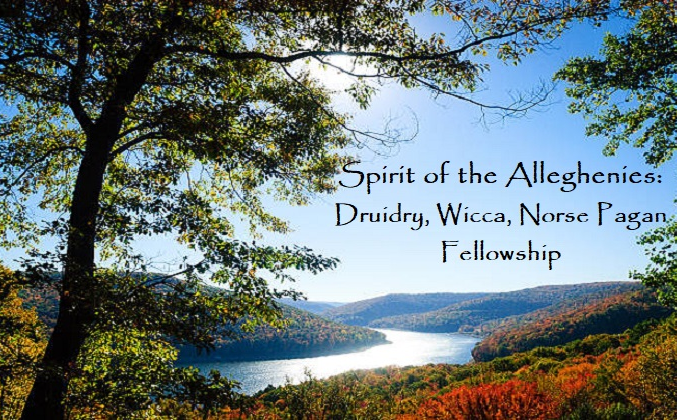Bearberry (Arctostaphylos uva-ursi) is a low-lying shrub that grows predominantly in soils composed of sand, gravel, or dunes in boreal forests. When smoked in a pipe, or when steeped as tea, bearberry leaves have a calming effect on the nervous system and are used to cure anxiety, migraine headaches, and general pain. Smoking is theContinue reading “Bearberry”
Tag Archives: Druidry
The Eagle on the Cliff
Am iolar i n-aill (Irish Gaelic)Om eller ih-n aisle (Phonetic) “I am the eagle on the cliff” ~ Amergin “He clasps the crag with crooked hands;Close to the sun in lonely lands,Ring’d with the azure world, he stands.The wrinkled sea beneath him crawls;He watches from his mountain walls,And like a thunderbolt he falls.”~ “The Eagle”Continue reading “The Eagle on the Cliff”
Casting the Druid Circle
The ceremonial circle is a timeless symbol of sacred space and spiritual protection. Within Druidry, the act of casting a circle is a foundational practice that connects one with nature, harmonizes energies, and provides a haven for ritual work. The author is a Druid in the Order of Bards, Ovates, and Druids, and his workContinue reading “Casting the Druid Circle”
Goddess Rosary
In this post, we are reclaiming the Roman Catholic rosary as a tool for worshiping the Goddess in modern pagan traditions. In the Roman Catholicism, the rosary is a devout and widely practiced form of prayer, consisting of a sequence of meditations that revolve around the repetition of the Hail Mary and Our Father prayers,Continue reading “Goddess Rosary”
Cernunnos
The tapestry of ancient Celtic mythology is adorned with a myriad of fascinating and enigmatic deities, each representing different facets of nature, life, and the cosmos. Among these, Cernunnos, whose Gaelic name translates to, ‘Horned One,’ stands as a symbol of fertility, nature, and the untamed wild. Who is Cernunnos? In his seminal essay onContinue reading “Cernunnos”
A Journey Around the Caim Part 3
Walking the Caim The most effective way to utilize the Caim is to walk the sacred circle. Those familiar with nature-based spiritualities will be familiar with this concept, but we are now performing it with the therapeutic approaches explained in the second article. Gather markers to place at the four directional points and at theContinue reading “A Journey Around the Caim Part 3”
A Journey Around the Caim Part 2
Modern Psychology & Caim Before giving the teaching on walking the caim, it will be useful to understand how modern psychology intersects with the ancient caim teachings. As a psychiatric technician at our regional medical facility, Warren General Hospital, I conduct therapy groups in our acute care inpatient mental health unit. I developed a therapyContinue reading “A Journey Around the Caim Part 2”
Stag ~ Gaelic: Damh (Dav [like Have]) / Norse: Steggi (Stay-gee)
Perhaps the most important prey animal hunted in ancient times, the stag served as a great provider for our ancestors. His hide covered our earliest homes and provided material for clothing, his meat sustained us during the difficult winter months, and his bones were fashioned into tools both sacred and ordinary. Celtic Symbolism: “IContinue reading “Stag ~ Gaelic: Damh (Dav [like Have]) / Norse: Steggi (Stay-gee)”
The Stag of Seven Tines
Am damh seacht bean (Irish Gaelic)Om dah-v shocked be-yawn (Phonetic) “I am the stag of seven tines.” The fourth line in Amergin’s spell-poem invokes the imagery of the majestic stag, which is fast, powerful, and sexually potent. An enduring symbol of royalty, stags represent power united with grace, and authority wed with dignity and integrity.Continue reading “The Stag of Seven Tines”
A Journey Around the Caim
The Irish Gaelic word Caim (pronounced Kime like Lime) means “Protection” or “Sanctuary”, a magical circle which guards one from harm. Each of the cardinal directions were understood to possess sacred associations relating to natural cycles such as the seasons, the four elements, the four quarters of the moon, the four ages of human life,Continue reading “A Journey Around the Caim”
Brighid
Brighid is the Celtic Triple Goddess of Smithcraft, Healing, and Poetry. She is connected to the elements water and fire. As a master smith, Brighid combines the awesome power of fire to forge metal and then quenches her creation in a basin of cool water. This same alchemical combination of fire water is practiced inContinue reading “Brighid”
Raven ~ Norse: Hrafn (H-ray-fen) / Gaelic: Bran (Bran)
Norse Symbolism In Norse mythology and culture, ravens played a significant role, serving as symbols of intelligence, wisdom, power, prophecy, and as messengers of the gods. Despite their association with death, ravens were seen as powerful protectors and guardians. It was believed that if a raven perched on a person’s home or property, that personContinue reading “Raven ~ Norse: Hrafn (H-ray-fen) / Gaelic: Bran (Bran)”
Origin of Ogham?
How did the Ogham script originate? In this post, I will put forward an origin theory for Ogham. Though controversial, this theory makes the most intuitive sense to me. In 1948, English poet Robert Graves published his landmark book The White Goddess, in which he linked the Welsh legend Cad Goddeu or Battle of theContinue reading “Origin of Ogham?”
The Battle of the Trees
Long before the arrival of the Celtic race on Albion’s fair shore, the children of Dôn, the Great Mother Goddess, and her consort Beli, the bright Sunlight, lived and prospered in the Kingdom of Cymru (Wales). The Goddess and the God had one daughter named Arianrhod, whose name means ‘Silver Wheel’, for her province isContinue reading “The Battle of the Trees”
What is Ogham?
Ogham, pronounced “Oh-um,” is a form of writing dating from the 4th century CE (and possibly earlier), which uses dashes or notches carved in a line into stone or wood, the number and position of which determining the letters. Each letter is representative of a native tree and is taken from the first letter ofContinue reading “What is Ogham?”
Chamomile
Used as an herbal remedy for thousands of years, Chamomile is used to treat an extensive list of ailments, including fever, headaches, kidney, liver, and bladder problems, digestive upset, muscle spasms, anxiety, insomnia, skin irritations, bruises, gout, ulcers, rheumatic pain, hay fever, inflammation, hemorrhoids, colic, and menstrual disorders. The generic name, Matricaria, comes from the Latin matrix,Continue reading “Chamomile”
“Trapped in a Bottle” Banishing Spell
For removing an evil presence from your home. “Evil” here refers to anything intending malicious harm against you , your family, home, etc… Materials: A rose (either wild or cultivated) , sea salted water (This can be made with sea salt added to spring water), a glass jar or bottle (wine bottles work very wellContinue reading ““Trapped in a Bottle” Banishing Spell”
Blue Vervain
Vervain (Verbena officinalis), also known as common vervain or common verbena, is a flowering perennial plant native to Europe, North America, and Asia. The plant is recognized by its jagged, tooth-shaped leaves and clusters of delicate, mauve or pale-purple blossoms. Rich in compounds known as flavonoids, vervain is a potent anti-inflammatory, antibacterial, antispasmodic, anti-depressant, anxiolytic,Continue reading “Blue Vervain”
Wintergreen
Wintergreen is easy to identify by the small, shiny, almost waxy oblong green leaves that come to a point where it connects to the stem (these leaves can also sometimes be purple). The underside of the leaves often has black speckles or dots. It sprawls out to form a woody groundcover. When you break apartContinue reading “Wintergreen”
White Cedar
The needles of the White Cedar (also called Arbor Vitae) may be dried and burned as an incense to purify an area from negative thoughts and energies, and to call in protector spirits, especially the spirits of one’s ancestors. The technique is known as smudging and involves wafting of the smoke about oneself and theContinue reading “White Cedar”




